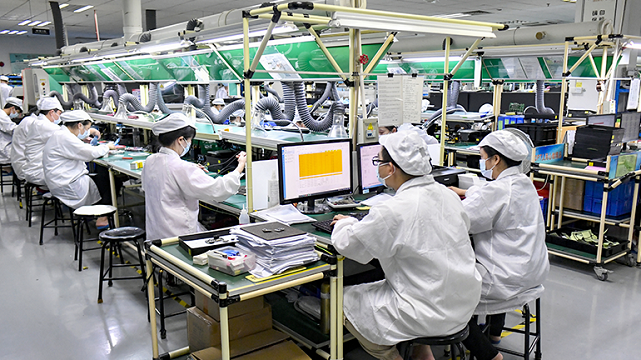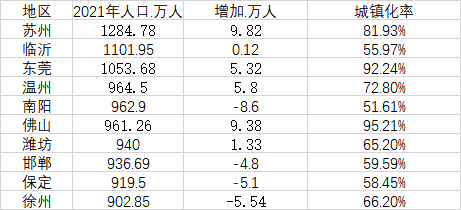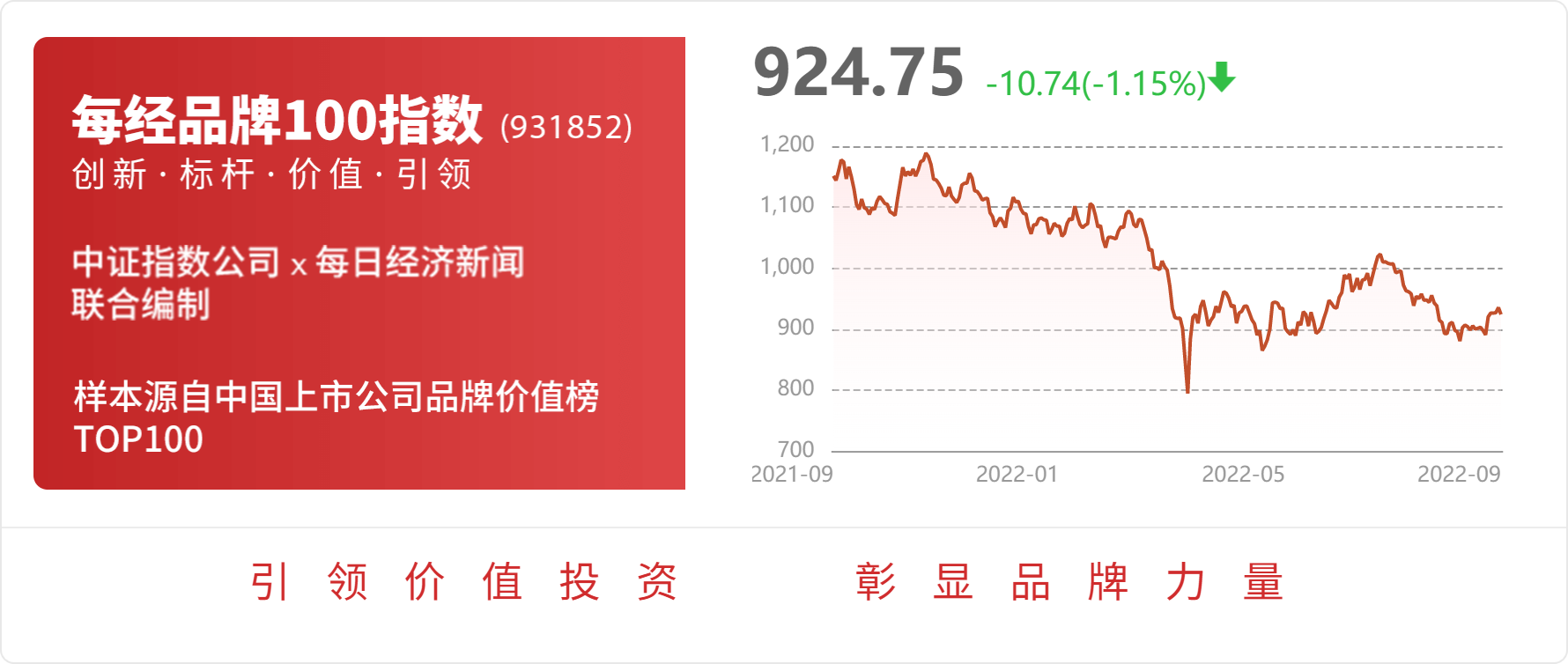The top ten prefecture -level cities with the largest population: the largest number of Suzhou, the highest density in Dongguan
Author:First financial Time:2022.09.18
18.09.2022

Number of this text: 2367, the reading time is about 4 minutes older
Introduction: As of 2021, there were more than 9 million resident population in 10 ordinary prefecture -level cities in my country, one less than the previous year, of which more than 10 million people in Suzhou, Linyi and Dongguan.
Author | First Finance Lin Xiaozhao
Except for municipalities, provincial capital cities, and planned cities, which ordinary prefecture -level cities have more population?
According to statistics from the First Financial Reporter, as of 2021, there were more than 9 million permanent population in my country in China, one less than the previous year. Among them, there were more than 10 million people in Suzhou, Linyi and Dongguan. Fourth, Weifang surpassed Handan to seventh; from the perspective of regional distribution, these 10 cities mainly came from the Yangtze River Delta, Pearl River Delta and Huanghuaihai Plain.
Three cities exceed 10 million
According to statistics from the First Financial Reporter, in 2021, the top ten prefecture -level cities in my country are Suzhou, Linyi, Dongguan, Wenzhou, Nanyang, Foshan, Weifang, Handan, Baoding, and Xuzhou. Essence
Among them, Suzhou topped the list with 12.8488 million people and ranked tenth among all cities across the country. Corresponding to the population, Suzhou is also the only ordinary prefecture -level city in the top ten cities across the country.
Suzhou's GDP reached 2271.8 billion yuan in 2021, more than 800 billion yuan more than the second place in the prefecture -level city. The four first -tier cities and municipalities in Guangzhou are also known as the "most premium -level city".
In terms of income, in 2021, the per capita disposable income of Suzhou residents exceeded 68,000 yuan, closely pursuing the two major first -tier cities of Guangshen, ranking fifth among major cities across the country.
The net inflow of population refers to the difference between the permanent residence and the population of the household registration. The permanent population is greater than the resident population, which indicates that the city's population is in a net inflow, and otherwise it is net outflow. Generally speaking, there are many employment opportunities in large and developed cities, which has formed a strong attractiveness to the flow of the flowing population. The first financial reporter sorted out that the current population of Suzhou is as high as 5.2267 million, ranking seventh in all cities across the country.
After Suzhou, Linyi City, Shandong in 2021, was 11.195 million, and the urbanization rate was 55.97%. Linyi is located in the southeast of Shandong Province, near the Yellow Sea, and northern Jiangsu in the south. According to public information, Linyi has a total area of 17,200 square kilometers. It is the largest population and largest city in Shandong Province. It is a logistics turnover center and a business wholesale center.
The "World Factory" Dongguan ranked third with 1.05368 million people. It is worth noting that in 2021, Dongguan's population density reached 4,259 per square kilometer, which is the most populous prefecture -level city.
Dongguan with an area of only 2474 square kilometers was promoted to prefecture -level cities in 1988. Since the reform and opening up, with the development of export trade, Dongguan has gradually developed into one of the world's largest manufacturing bases. The eight major industries are the modern industrial system of the pillar. The development of the industry has also led to a large number of population flow. At present, the net inflow population in Dongguan is as high as 7.75 million.
Wenzhou, a private economy city, surpassed Nanyang in 2021 and rose to the fourth place in the city. A few days ago, the "Long -term Plan for the Development of Wenzhou Population" was released, showing that by 2025, Wenzhou's permanent population will strive to reach 10 million; the total number of high -skilled talents has reached 400,000, and 600,000 graduates of colleges and universities will be introduced. The proportion of skill workers reaches 30%; at the same time, the population distribution is more reasonable, and the urbanization rate of the permanent population in the city has reached 75%. By 2030, the status of the "Ten Thousands of Frequently Residents City" will be more consolidated. By 2035, the advantage of the "Ten Thousands of Frequently Residents" has become more prominent.
Tang Haiyu, deputy chairman of the expert committee of the Hangzhou Planning Commission, analyzes the first financial analysis of the first financial and economic analysis, is a relatively large challenge for Wenzhou. Because even if it is a central city like Hangzhou, population growth has slowed and adjusted significantly. Therefore, the growth of Wenzhou's population in the future depends on the economic and social development of cities to a greater extent.
Tang Haizheng said that Wenzhou will need to give full play to his location advantage in the future and play more to drive and radiate the radiation role in the central city in the area. In the future, the energy level and functions of Wenzhou central cities need to be further improved. This improvement is not only within Wenzhou, but also breaks through the administrative boundary.
Outside of Wenzhou, of the top ten, another prefecture -level city with an increase in the ranking of the resident population is Weifang. Although the Weifang population only increased by more than 10,000 last year, the total amount surpassed Handan and rose to the seventh place in the city level.
It is worth noting that last year, Weifang's GDP ranked 35th in all cities across the country, an increase of 4 more than the previous year. Weifang has many listed companies such as Weichai, Chenming, and Goer. Among the 371 provincial manufacturing single champion selected from 2017 to 2020, Weifang owned 57, ranking first in 16 cities in Shandong.

Top ten ordinary prefecture -level cities with the largest permanent population (data source: First Financial reporter to organize data based on public data)
Huanghuaihai Plain Concentration
From the perspective of regional distribution, these 10 cities mainly come from the Yangtze River Delta, Pearl River Delta and Huanghuaihai Plain. Among them, there are the most cities from the Huanghuaihai area, including Nanyang, Handan, Baoding, Xuzhou, Weifang and Linyi. In addition, some of the top 10 population cities also come from this area. For example, Zhoukou in Henan, although the permanent population fell below 9 million last year, there were still 8.853 million. Heze, Jining, and Fuyang are also large cities with more than 8 million permanent population. Among them, there were 8.171 million people located in the northern Anhui region. The nearby prefecture -level city of Luzhou officially separated from Fuyang's establishment of a prefecture -level city in 2000. The total resident population of the two places exceeded 15 million.
Niu Fengrui, a researcher at the City Development and Environment Research Center of the Chinese Academy of Social Sciences, analyzed the first financial reporter that the plain area of Huanghuaihai was large, the agricultural production conditions were good, and the population density was relatively large. The city has also gained a lot of counties, which is easier to form a large population city.
For example, there are currently 2 cities, 10 counties and 1 county -level cities in Nanyang; 6 districts, 11 counties, and 1 county -level cities in Handan; 2 districts, 7 counties, and 1 county in Zhoukou Class city.
However, it is worth noting that in these large population cities, many cities have a significant decrease in resident population. For example, in 2021, Nanyang's resident population decreased by 86,000, Handan's resident population decreased by 48,000, Baoding decreased by 51,000, and Xuzhou decreased by 55,400. In Zhoukou, which is ranked 11th in the prefecture -level city, the resident population fell below the 9 million mark in 2021, a decrease of 166,000.
However, Niu Fengrui believes that the decline in the population of these cities is only as a reduction in the population of the administrative district as the concept of the city, which is not equal to the decrease in the urban population. These cities often have large rural areas, and there are many rural populations. The main flow of population is the rural areas of the jurisdiction. Some of these populations are transferred to the developed land levels in the southeast coast and the provincial capital cities and other places where the provinces are located. The population should be near urbanization and flow into urban areas where the city is located. Therefore, in the future, the population of these large population cities in the city is still relatively large.
Niu Fengrui said that in general, central cities and large cities are mainly based on the service industry. In contrast, the manufacturing industry needs more land, the land resources of the large population are rich, and the labor force is relatively rich. Therefore, these cities should be based on manufacturing based on manufacturing Industry, give full play to its own advantages, develop some industries with a large demand for labor, and accelerate the process of urbanization nearby.
- END -
Leading Intelligent Manufacturing: Cumulative repurchase of approximately 63.62 million shares, accounting for 0.9%

Every time AI News, Yiyi Intelligent Manufacturing (SZ 002600, closing price: 5.42...
The deputy chief of the science and technology gathered "group" to the "Zibo Road"

□ Zibo Daily/Zibo Evening News/Expo NewsReporter Zhao Ruixue Correspondent Zhang ...